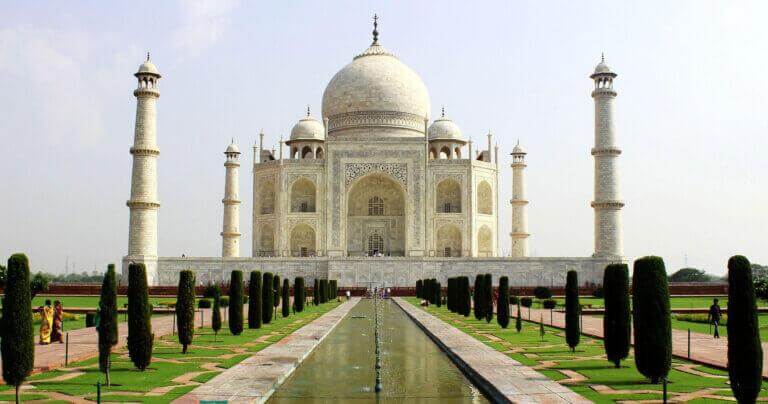Imagine the Taj Mahal. The lush, green gardens surrounding a rectangular pool of clear water. The white marble domes command your attention as they stand in all their glory in front of you. In the distance you can see the red sandstone mosque emerge. The Yamuna River softly rushes as it winds its way around the estate.

Innovations
The Taj Mahal in Agra is the greatest achievement in Indio-Islamic architecture to date. It has some unique innovations for the time that make it so special.
First up is the octagonal marble latticework. It allows for ventilation and seeing the outside without being exposed.
Then, placing the tomb at the end of the garden instead of the center was unheard of.
Finally, all the buildings that make up the Taj Mahal are freestanding. Not to mention its impressive scale, standing at 73 meters tall.
Influences
The most prominent feature of Indian architecture is the lotus flower that is featured atop all of the domes. The symbolism in Hinduism of the lotus flower is eternity and good fortune. The Taj Mahal definitely lives up to that, enjoying eight million tourists annually.
The design of the tomb is primarily Islamic. It’s based on a structure that represents the unity between Heaven and Earth. The tomb stands on a platform symbolizing the universe. The calligraphy found throughout is of Islamic origin, spelling out Allah and passages from the Qur’an.
The Persians were very influential in the overall design of the Taj Mahal. The arches, minarets, and even the name Taj Mahal reflect the Persian influence. The octagonal pattern in the latticework even has meaning for the Persians. It denotes spirituality.
Construction
Many artisans were commissioned in 1632 by Shah Jahan, the fifth emperor of the Mughal empire, for his wife. During her life they shared a strong bond. They were married young, and the couple had 14 children together. When she passed away, he was inconsolable and the Taj Mahal was built to honor her memory.
Shah Jahan’s wife was given the name Mumtaz Mahal meaning “jewel of the palace”. The Taj Mahal contains precious stones and gems built into it. During the day, the marble appears to be different colors. This is said to be representative of a woman’s many moods.
Environmental Protections
It’s no secret that the air pollution in India is high. Unfortunately, even the Taj Mahal can’t escape its effects. The Taj is starting to deteriorate.
In order to help keep the deterioration at a minimum, some protections have been put in place. The air quality is constantly being monitored. There is a buffer zone around the Taj Mahal where a strict no coal burning policy is enforced. No cars or buses may come closer than 500 meters as part of this effort to protect the Taj Mahal. This buffer zone, known as the Taj Trapezium Zone, or TTZ, includes 40 other monuments as well.
Fun Facts
The Taj Mahal was recognized in 1983 as a UNESCO World Heritage Site. It later became part of the new Seven Wonders of the World in 2007.
The Taj Mahal’s mosque is still in use today. In fact, only practicing Muslims may visit on Fridays even though it is closed to the general public.
The Taj Mahal’s four minarets were constructed such that if any of them were to fall, they wouldn’t damage the main dome.
Though the mosque floor is made completely of tile, it marks a space for 569 individual prayer mats.
The mausoleum houses two false tombs covered by lattice screens. It is said that the screens protect the tombs from the watchful eyes of onlookers.
The Taj Mahal would cost nearly 82 billion rupees or close to 1 billion US dollars if built using today’s money. Shah Jahan is said to have spent 32 million rupees.
Though the emperor and his wife have come and gone, it is clear that their love hasn’t gone anywhere. Maatir encourages you to share in the charming paradise he created. Enjoy our collection of … featuring the alluring Taj Mahal.




